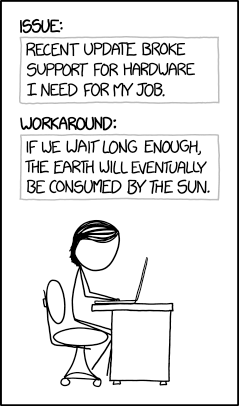
Why would anyone worry about user experience for anything that’s not customer-facing?
This question was the premise of Maurice Roach’s post in the Zühlke blog, “Empathise with your users or you won’t solve their problems”:
Bring up the subject of user empathy with some engineers or product owners and you’ll probably hear comments that fall into one of the following categories:
- Why do we need to empathise when the requirements tell us all we need to know about the problem at hand?
- Is this really going to improve anything?
- Sounds like an expensive waste of time
- They’ll have to use whatever they’re given
These aren’t unexpected responses, it’s easy to put empathy into the “touchy feely”, “let’s all hug and get along” box of product management.
Roach’s answers:
Empathy does a number of things, but mainly it increases the likelihood that the delivery team will think of a user and their pain points when delivering a feature.
If an engineer, UX designer or product owner will has sat with a user, watched them interact with their current software or device they will have an understanding of their frustrations, concerns and impediments to success. The team will be focused on creating features with the things they have witnessed in mind, they’re thinking about how their software will affect a human being and no amount of requirement documentation will give them that emotional connection.
…
Empathy can also help to develop a shared trust in the application development process. The users see that the delivery team are interested in helping to solve their problems and the product delivery team see the real users behind the application.
All of these are valid reasons, but the list is incomplete. All of these answer the question from a software development point of view. To his credit, Roach pushes past the purely technical aspects into the world of the user. This expanded exploration of the context is, in my opinion, absolutely essential. What’s presented above is an IT-centric viewpoint that needed to be married with a business-centric viewpoint in order to get a fuller picture.
Nick Shackleton-Jones, in his post “The Future Is… Organisational Usability!”, outlined on the problem:
Here’s how your organisation works: you hire people who are increasingly used to a world where they can do pretty much anything via an app on their iPhone, and you subject them to a blizzard of process, policy, antiquated systems and outdated ways of working which pretty much stop them in their tracks, leaving them unproductive and demoralised. Frankly, it’s a miracle they manage to accomplish anything at all.
As he notes, enterprises are putting a lot of effort into digital initiatives aimed at making it easier for customers to engage with them. However:
…if we are going to be successful in future we need to make it much easier for our people to do their jobs: because they are going to be spending less time with us, and because we want engagement and retention, and because if we require high levels of capability (to work our complex systems) then our resourcing costs will go through the roof. We have to simplify ‘getting stuff done’. To put it another way: in an ideal world, any job in your organisation should be do-able by a 12-yr old.
While I disagree that “any job in your organisation should be do-able by a 12-yr old”, Shackleton-Jones point is well-taken that it is in the interests of the business to make it easier for people to do their jobs. All aspects of the system, whether organizational, procedural or technological, should be facilitating, not hindering, the mission. Self-inflicted, unnecessary impediments are morale-killers and degrade both effectiveness and efficiency. All three of these directly impact customer-experience.
While this linkage between employee user experience and customer experience makes usability important for line of business systems (both technological and social), it has value for peripheral systems as well. Time people spend on ancillary tasks (filling out time sheets, requesting supplies, etc.) is time not spent on their primary duties. You may not be able to eliminate those tasks, but you can minimize their expense by making them quick and easy to complete. The further someone’s knowledge/skill/experience level gets from “do-able by a 12-yr old”, the bigger the savings by paying attention to this.
Rather than asking if you can afford to pay attention to user experience, you might want to ask whether you can afford not to.






